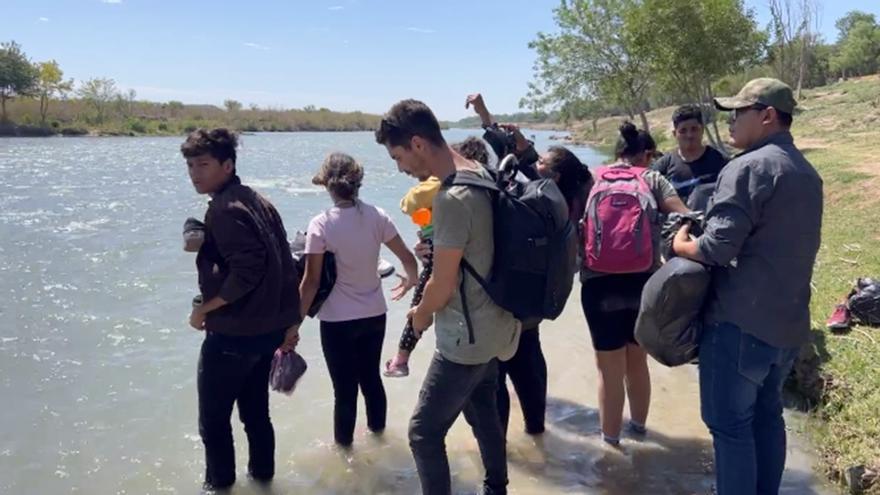
![]() 14ymedio, Ángel Salinas, Mexico, 14 April 2022 — There is no official figure, but “this week on average almost 1,300 people a day crossed the Rio Grande from the Mexican city of Piedras Negras (Coahuila) to Eagle Pass (USA),” Francisco Manrique, a member of Mexican government’s Grupo Beta de Protección a Migrantes, confirms to 14ymedio.
14ymedio, Ángel Salinas, Mexico, 14 April 2022 — There is no official figure, but “this week on average almost 1,300 people a day crossed the Rio Grande from the Mexican city of Piedras Negras (Coahuila) to Eagle Pass (USA),” Francisco Manrique, a member of Mexican government’s Grupo Beta de Protección a Migrantes, confirms to 14ymedio.
“The Cubans reach the banks of the river in groups of up to 60 people with Nicaraguans and some Venezuelans,” says the rescuer. “If we talk about Acuña and Piedras Negras, the passage of Antilleans through the channel exceeds 300.”
Some of these crossings were captured by journalist Ricardo Arambarri from Univisión. He verified the persecution of municipal police against a group of at least 17 Cubans who were running towards the river. “It is as if the floodgates were opened so that they could reach the water.” Some fall and manage to get up to reach their goal, others are caught.
“The municipal and liaison police chase those who don’t pay,” says Joel Santos, a resident of Guerrero Street, which is less than 10 minutes away from the so-called Black Railroad Bridge, in Piedras Negras. “These people are passing through there. When the patrols see them, they stop them and charge them money to let them reach the shore.”
Santos affirms that Haitians, Salvadorans and Guatemalans are charged in pesos, “about 100 or 200” ($5 to $10 USD), but Cubans, “they ask for 100 dollars.” They are distinguished by the way they dress, affirms the local, “the brand of tennis shoes, the clothes” and some are blond or dark-haired with blue or green eyes.
These extortions had already been documented by Ramón Tejera, when police stopped the bus in Ciudad Acuña in which he was traveling with several migrants, all with a transit safe-conduct pass. On their way to the US border, Cubans pay fees to police at checkpoints and those who do not are detained, even if they have permits to be in the country. For not paying a bribe to Immigration, Tejera was returned to the Island along with his wife and daughter.
The Facebook user identified as José López published a video on Facebook on Wednesday in which Coahuila Specialized Police agents are observed extorting money from Central American migrants. Given the evidence, three people were arrested. The Secretary of State Public Security, Sonia Villarreal Pérez reported this Thursday while opening an investigation for the “collection of fees from foreigners at a checkpoint.”
The possibility for parole (being allowed entry to the US) for Cubans announced in March has increased the migratory flow through Ciudad Acuña to reach Del Río (USA), and the US Immigration and Customs Enforcement Service (ICE) has publicized that the Cuban government’s recently announced policy that it will not accept back to the Island Cubans deported by the Biden government. This “will generate a bigger problem for Coahuila,” said Manrique, a rescuer from Grupo Beta. “This can overwhelm us, we are already seeing it.”
This is no time to challenge the Rio Grande. Local media carry out night tours, in which they have videotaped the passage of Cubans under the Black Railway Bridge. ImpactoVisión Noticias shared the moment in which a family, including four adults and two minors, manage to arrive in Texas.
Among the figures the Rio Grande generates, is the record of deaths. As of this Thursday, Civil Protection reports 47 deaths in attempts to reach the US. This Wednesday morning, the discovery of a body was reported at the height of the Morelos neighborhood. Two more, one person from the Dominican Republic, were confirmed by Eagle Pass authorities and in the afternoon neighbors reported a body floating yards from the border bridge.
____________
COLLABORATE WITH OUR WORK: The 14ymedio team is committed to practicing serious journalism that reflects Cuba’s reality in all its depth. Thank you for joining us on this long journey. We invite you to continue supporting us by becoming a member of 14ymedio now. Together we can continue transforming journalism in Cuba.
